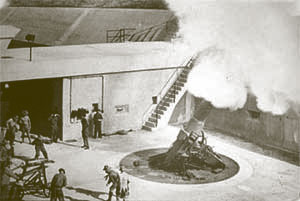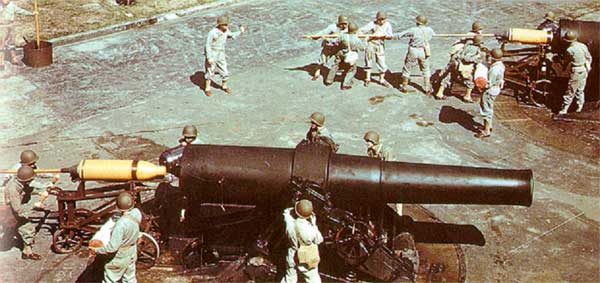|
Battery Barlow-Saxton
Eight 12" Rifled Mortars
Construction of batteries John
Barlow and Rufus Saxton commenced on April 1, 1915 and was
completed on June 27, 1919. The excavation for the structure
was done almost entirely by hand labor due to a lack of
available heavy machinery in the area. The powder and shell
magazines are located underground to the front of the
building and are accessed by a series of doors located
between the guns.
Eight twelve-inch M-1912 mortars on
M-1896 M-III carriages were mounted in these |

Battery Barlow - Saxton in action
during the 1930's |
|
batteries. The guns had a range
of about eleven miles and could be turned 360 degrees which
gave them the ability to be fired into the city to provide
some protection to the rear of the fort incase it was
attacked from that direction.
The design of Battery Barlow-Saxton with its four, two gun
pits in a lateral arrangement, make it the only
architectural example of its kind in the continental United
States. Its design represented a radical new thinking of
mortar battery technology that allowed the gun crews to be
more efficient while increasing the number of guns that
could be fired or serviced at the same time.
In 1943, the Army decided that it was time to retire the
guns of Battery Barlow – Saxton. The guns were finally
scrapped just after the end of World War Two.
|
|

Battery Barlow -
Saxton under construction and almost ready for service 1919 |
|
Battery
Barlow is named for Brigadier General John Whitney Barlow
(1838-1914) a graduate of the US Military Academy at West
Point class of 1861. His classmates remembered him as “an
entirely lovable person” and a devout Christian. He served
as an engineer during the battle of Gettysburg, the siege of
Atlanta, and supervised the construction of the defenses of
Nashville.
From 1870-1874 he was the chief engineer for the Military
Division of Missouri. During this time he made several
scientific explorations of the Missouri and Yellowstone
Rivers. His detailed reports later became trusted guides for
settlers and later helped set the boundaries for Yellowstone
National Park. In 1891, he was promoted to Lt Colonel and
from 1892-1896 served as the senior American member of the
international commission that re-marked the disputed boarder
with Mexico.
On May 2, 1901 John Barlow was commissioned as a Brigadier
General and appointed Chief of Engineers. He retired from
the army the next day at his own request after 40 years of
military service. In 1913 General Barlow and his wife
traveled to Jerusalem, Palestine, where the general took ill
and died. General Barlow is buried in the Arlington National
Cemetery. |
|
|
Battery Saxton is named for Major General Rufus Saxton
(1824-1908) a graduate of the US Military Academy at
West Point class of 1849. Prior to the Civil War, Saxton fought against
Seminole Indians in
Florida,
and as an artillery tactics instructor at West Point. During
this period he also patented a self-registering thermostat
for deep-sea soundings. During the Civil War he served on
the staff of General McClellan and commanded the defenses of
Harpers Ferry from May through June of 1862. For his actions there he would
later be awarded the Congressional Medal of Honor for
“Distinguished gallantry and good conduct in the defense”.
After his service at Harpers Ferry, he was
placed in charge of the enlistment and organization of
negroes into the Union Army. After the war ended,
Saxton
was appointed as the Assistant Commissioner of the
Freedman’s Bureau and spoke before Congress on the
subject of civil rights for African Americans. Major
General Saxton was forced to retire in 1888 having
reached the mandatory retirement age of 65. He died on
February 23, 1908 and is buried in the
Arlington National Cemetery. |
|
|

One of the last know photographs of
Battery Barlow - Saxton in operation 1943 |
|
 |
|
The Guns of Fort MacArthur |
 |
|
|
|